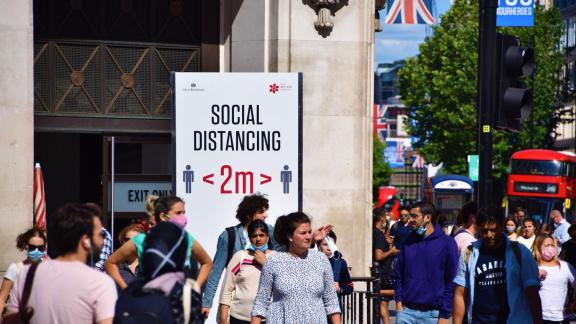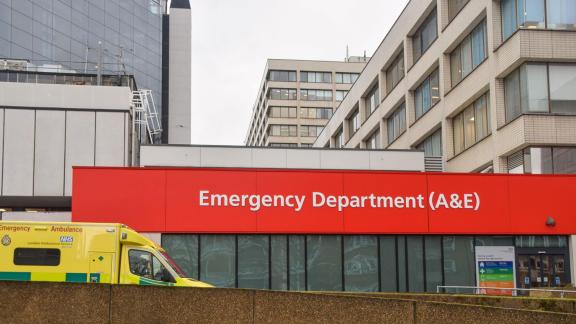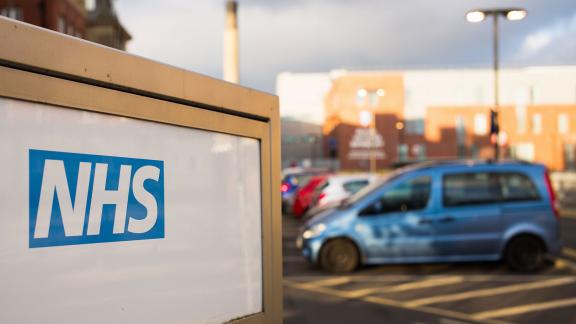Key points
- The government is expected to publish its COVID-19 exit plan on 21 February. This comes a month earlier than initially scheduled and is expected to lift existing restrictions – including the requirement to isolate after testing positive – in England from 24 February.
- Given the continued high prevalence of the Omicron variant, and pressures on services, this plan must represent a cautious and carefully planned exit if the NHS is to continue to concentrate on delivering the full range of care that people value and expect.
- A survey of NHS Confederation members, which asked what elements of the plan should be maintained, highlighted the importance of prevention and limiting transmission. Over 90 per cent of more than 300 health leaders who responded showed strong support for the continued provision of free tests for key workers and the public, as well as retaining the use of masks in healthcare settings.
- Around three-quarters of respondents said that they would be against ending the compulsory self-isolation period. There was over 80 per cent support for the Office for National Statistics survey to continue in order to monitor case levels and enable the NHS to plan accordingly, should infections increase rapidly, or a new variant appear.
- In addition to these important preventative measures, the government’s exit plan must be accompanied by unambiguous messaging and guidance for the NHS and the public and a preparedness plan for future waves or even pandemics. This should include maintaining the necessary infrastructure to be able to rapidly ramp up COVID-19 measures and capacity, in areas such as diagnostics capacity.

Introduction
The government is expected to publish its COVID-19 exit plan on 21 February. This follows the Prime Minister’s move to lift all COVID-19 restrictions – including the requirement to isolate after testing positive – in England from 24 February.
While we welcome the positive move towards greater freedoms, there is cause for caution given the threat of future variants. Experts have warned that COVID-19 mutations could be more dangerous, cause higher numbers of deaths and lead to more cases of serious illness than Omicron.
If the right steps are taken, England will be better able to ensure a safely managed transition to the next phase of living with COVID-19. It will also be well prepared to safely and efficiently manage future surges of current or new variants. A cautious and carefully planned exit would also enable the NHS to continue to concentrate on delivering the full range of care that people value and expect.
But what needs to be included in the plan to ensure this happens?
We put the question to our members – the organisations that plan, provide and commission NHS services – asking to what extent they agree or disagree with proposed changes to testing, self-isolation, mask wearing and infection surveys.
More than 300 leaders responded to our flash survey, which closed 16 February. Responses came from all parts of the NHS in England, with 35 per cent representing NHS trusts, 36 per cent from primary care and 24 per cent from integrated care systems and clinical commissioning group leaders (the remaining 5 per cent selecting 'other'). Responses came from each of the seven regions in England.
Survey findings
Key messages from the survey:
- Overwhelming support for free tests for key workers to remain (94 per cent), and strong support for free tests to continue for all members of the public (78 per cent).
- Very strong support for retaining the use of masks in healthcare settings (81 per cent).
- Three-quarters said they would be against ending the compulsory self-isolation period, although this was the move that leaders felt least strongly about, with 21 per cent expressing support.
- Overwhelming support for the Office for National Statistics (ONS) survey to continue (83 per cent), to both monitor prevalence in the population and identify emerging variants .
Within the survey, respondents were asked to indicate the extent to which they agreed or disagreed with each of five potential changes rumoured to be included in the government’s COVID-19 exit plan. The chart below provides more detail on how responses breakdown.
What should be included in the COVID-19 exit plan?
The government’s top priority should be prevention and limiting transmission – including through testing, mask wearing and appropriate self-isolation requirements. The exit plan must be accompanied by clear actions to monitor the situation and unambiguous messaging and guidance for the NHS and the public. This includes six key elements:
1. Continuation of the compulsory self-isolation period – or for any changes to be accompanied by clear guidance that recommends people still self-isolate if they could put others at risk
Vaccines and Omicron's reduced severity have helped to break the link between infections and deaths. But removing the requirement to self-isolate after testing positive could be premature: one in 20 people in England are estimated to have COVID-19, and there remains a threat of new, more deadly variants.
As recently as December the impact of a surge in cases was evident: A&E waiting times rose to the longest on record and nearly 13,000 patients spent over 12 hours on trolleys waiting for a hospital bed. Even if a resurgence of cases is not expected to the extent seen this winter, the impact of COVID-19 spreading falls disproportionately on the most vulnerable. As a nation, we should practice caution when considering how to control the spread.
2. Continued provision of free testing for NHS and care staff
The strong response from leaders in favour of continued access to free COVID-19 testing for staff reflects the sensitive work they deliver on the frontline of care, supporting clinically extremely vulnerable patients, service users, carers and staff. Members have reported that even with triple vaccination people (staff and patients) are getting very ill in some circumstances.
Testing is not only a reasonable precaution but means that providers can continue to fulfil their statutory health and safety duties for infection disease control. Therefore, taking a different approach for health and care staff makes sense.
Regular testing can help to identify people who may be infectious without showing symptoms. But for the policy to be most effective, it should be accompanied by clear guidance on what actions NHS staff who test positive should take. Given the continued prevalence and infectious nature of COVID-19 cases, now is not the time to end this measure.
“Often it is the most vulnerable who come into contact with key workers the most. Free testing should continue.”
3. Continuation of the ONS infection survey
The Office for National Statistics’ (ONS) COVID-19 infection survey provides the government, public health services and the NHS with key information about how many people are contracting the virus. The information from monitoring case levels in this way enables services to identify upcoming surges in different parts of the country and may indicate the emergence of new variants. This enables local and national organisations to plan accordingly – taking steps to reduce the impact of potential surges and preparing for upcoming increases in demand and staff sickness.
Early planning is key for a system that operates close to full capacity. The UK has just 2.4 beds per 1,000 people compared to Germany with 7.9. In England in week ending 13 February, bed occupancy was 93.6 per cent in adult general and acute beds. Eleven trusts reported occupancy in adult general and acute beds of over 98 per cent, well above recommended levels.
“The virus may mutate again, and until we have several years' more data, it would be good to continue with the survey, albeit it has flaws. And if this coming winter will include flu, COVID-19 and winter pressures, it would be useful to know exactly what pressure COVID-19 is putting on hospitals.”
“This should never be considered, or we will never pick up new variants, which are guaranteed to arise.”
4. Continue to mandate the wearing of masks in healthcare settings
We welcome the continued funding for personal protective equipment (PPE) in health and care settings until March 2023. However, protective equipment for staff is only half of the solution. Continuing to mandate mask wearing in healthcare settings for all will reinforce the message that there is still a risk of spreading COVID-19 and that this is not without consequence.
That the ask is specific to healthcare settings is important and in line with the National Institute of Health Research’s ‘living review’. The review provides consistent and robust evidence for the association between mask use and decreased infection risk from SARS-CoV-2 in healthcare workers. It not only helps to protect staff from sickness and reduce absence at a time when health and care organisations can least afford to lose staff, but also allows staff to feel respected and protected in their place of work.
“Masks will protect vulnerable patients (who will otherwise be nervous about coming in) and our staff from COVID-19 and other circulating respiratory viruses. Levels are still too high to stop wearing masks.”
“This appears to have had an impact on the spread of all community-based infection in healthcare settings so should remain for IPC reasons wider than COVID-19.”
5. Ensure the government maintains the infrastructure required to ramp up again, if needed
One of the most important lessons the healthcare system and nation have learned is the importance of being adequately prepared for a pandemic. We petition the government to maintain the necessary infrastructure to be able to rapidly ramp up COVID-19 measures and capacity, while continuing to deliver elective care in the case of another wave. This includes building on the strength of our diagnostics infrastructure, testing and surveillance capacity, as well as the logistics and digital infrastructure to reach people outside traditional healthcare settings – as argued for by Dr Axel Heitmueller, managing director of Imperial College Health Partners.
Having the confidence to know that elective capacity will not be impacted by emergency demand and that the service will not be overwhelmed as soon as cases rise, will enable the NHS to plan more effectively. It will enable the health service to continue to reduce the now significant elective backlog and deliver quality care. Leaving the uncertainty of the last two years behind is just one factor in reducing waiting lists, but will help to create the stability to start the recovery.
6. Clear messaging on all COVID-19 measures and expectations of the public
Ambiguity will need to be avoided and the lessons learned from past campaigns. Any changes to rules must be accompanied by clear messaging to the public on what that means for them and their role. The government should provide guidance on when self-isolation may indeed be required – that is, when people could put others at risk. Similarly, messaging around why it is important for people to wear masks in healthcare settings, and expectations for the public, should be set out. It should not be left only to frontline clinicians to have to deliver the message as they deliver care.
Living with COVID-19 does not mean all risk is eliminated, but rather that people will still be vulnerable to infection with severe consequences. This includes the 1.3 million people in the UK experiencing long COVID, according to the ONS. Prevention for these people is key.
Viewpoint
Without consultation, the government has brought forward, by a month, the decision to lift COVID-19 restrictions and move England into the next phase of the pandemic. Although the trend for infections of the most recent variant is encouraging, based on the views of our members and what we know about where the service is in the recovery, it is clear this is a make-or-break moment.
We do not argue for all restrictions to stay in place without a deadline, but for this to be approached cautiously. If the right steps are taken, the NHS is put on a strong footing to deliver the challenging elective recovery targets it has been set, and staff will feel safe and confident. Get it wrong and we perpetuate the challenges of the last two years.



